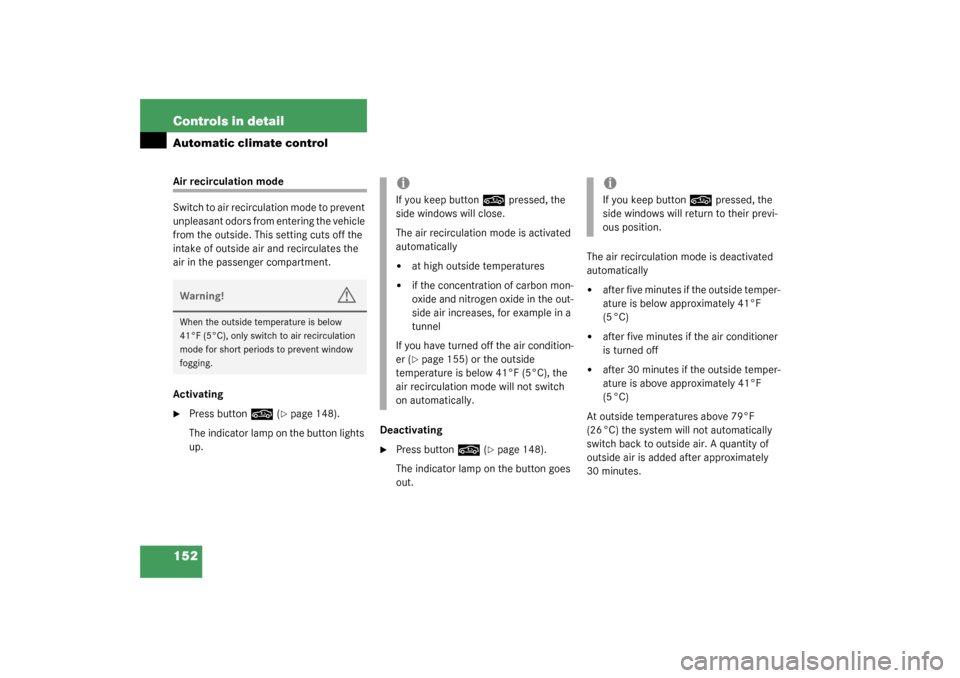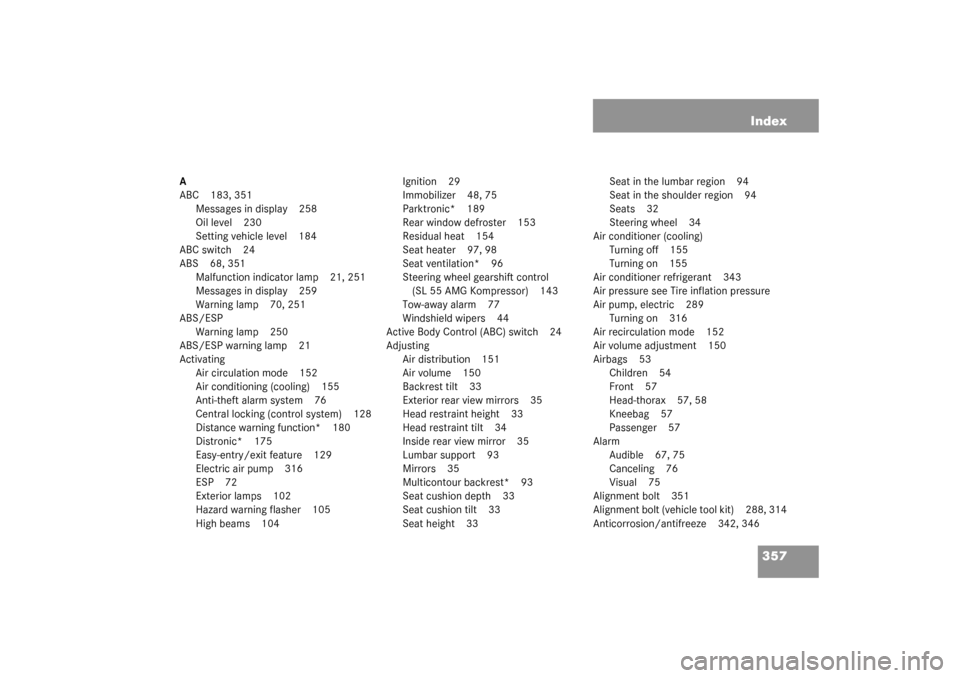Page 53 of 376

53 Safety and Security
Occupant safety
AirbagsWarning!
G
Airbags are designed to reduce the potential
for injury resulting from certain frontal im-
pacts (front airbags, driver-side kneebag) or
side impacts (head-thorax airbags) which
may cause significant injuries. However, no
system available today can totally eliminate
injuries and fatalities.
The activation of the SRS temporarily releas-
es a small amount of dust from the airbags.
This dust, however, is neither injurious to
your health, nor does it indicate a fire in the
vehicle. The dust might cause some tempo-
rary breathing difficulty for people with asth-
ma or other breathing trouble. To avoid this,
you may wish to get out of the vehicle as
soon as it is safe to do so. If you have any
breathing difficulty but cannot get out of the
vehicle after the airbag inflates, then get
fresh air by opening a window or door.
Warning!
G
To reduce the risk of injury when the front
airbags inflate, it is very important for the
driver and passenger to always be in a prop-
erly seated position and to wear your seat
belts.
For maximum protection in the event of a
collision always be in normal seated position
with your back against the backrest. Fasten
your seat belt and ensure that it is properly
positioned on your body (
�page 37).
Since the airbag inflates with considerable
speed and force, a proper seating and hands
on steering wheel position will help to keep
you at a safe distance from the airbag. Oc-
cupants who are unbelted, out of position or
too close to the airbag can be seriously in-
jured by an airbag as it inflates with great
force in the blink of an eye:
�
Sit properly belted in an upright position
with your back against the seat back-
rest.
�
Adjust the driver seat as far as possible
rearward, still permitting proper opera-
tion of vehicle controls. The distance
from the center of the driver’s breast-
bone to the center of the airbag cover on
the steering wheel must be at least ten
inches (25 cm) or more. You should be
able to accomplish this by a combina-
tion of adjustments to the seat and
steering wheel. If you have any prob-
lems, please see your authorized
Mercedes-Benz Center.
�
Do not lean with your head or chest
close to the steering wheel or dash-
board.
�
Keep hands on the outside of steering
wheel rim. Placing hands and arms in-
side the rim can increase the risk and
potential severity of hand / arm injury
when driver front airbag inflates.
�
Adjust the passenger seat as far as pos-
sible rearward from the dashboard when
the seat is occupied.
Page 152 of 376

152 Controls in detailAutomatic climate controlAir recirculation mode
Switch to air recirculation mode to prevent
unpleasant odors from entering the vehicle
from the outside. This setting cuts off the
intake of outside air and recirculates the
air in the passenger compartment.
Activating�
Press button
,
(�page 148).
The indicator lamp on the button lights
up.Deactivating
�
Press button
,
(�page 148).
The indicator lamp on the button goes
out.The air recirculation mode is deactivated
automatically
�
after five minutes if the outside temper-
ature is below approximately 41°F
(5 °C)
�
after five minutes if the air conditioner
is turned off
�
after 30 minutes if the outside temper-
ature is above approximately 41°F
(5 °C)
At outside temperatures above 79°F
(26 °C) the system will not automatically
switch back to outside air. A quantity of
outside air is added after approximately
30 minutes.
Warning!
G
When the outside temperature is below
41°F (5°C), only switch to air recirculation
mode for short periods to prevent window
fogging.
iIf you keep button
,
pressed, the
side windows will close.
The air recirculation mode is activated
automatically
�
at high outside temperatures
�
if the concentration of carbon mon-
oxide and nitrogen oxide in the out-
side air increases, for example in a
tunnel
If you have turned off the air condition-
er (�page 155) or the outside
temperature is below 41°F (5°C), the
air recirculation mode will not switch
on automatically.
iIf you keep button
,
pressed, the
side windows will return to their previ-
ous position.
Page 357 of 376

357 Index
A
ABC 183, 351
Messages in display 258
Oil level 230
Setting vehicle level 184
ABC switch 24
ABS 68, 351
Malfunction indicator lamp 21, 251
Messages in display 259
Warning lamp 70, 251
ABS/ESP
Warning lamp 250
ABS/ESP warning lamp 21
Activating
Air circulation mode 152
Air conditioning (cooling) 155
Anti-theft alarm system 76
Central locking (control system) 128
Distance warning function* 180
Distronic* 175
Easy-entry/exit feature 129
Electric air pump 316
ESP 72
Exterior lamps 102
Hazard warning flasher 105
High beams 104Ignition 29
Immobilizer 48, 75
Parktronic* 189
Rear window defroster 153
Residual heat 154
Seat heater 97, 98
Seat ventilation* 96
Steering wheel gearshift control
(SL 55 AMG Kompressor) 143
Tow-away alarm 77
Windshield wipers 44
Active Body Control (ABC) switch 24
Adjusting
Air distribution 151
Air volume 150
Backrest tilt 33
Exterior rear view mirrors 35
Head restraint height 33
Head restraint tilt 34
Inside rear view mirror 35
Lumbar support 93
Mirrors 35
Multicontour backrest* 93
Seat cushion depth 33
Seat cushion tilt 33
Seat height 33Seat in the lumbar region 94
Seat in the shoulder region 94
Seats 32
Steering wheel 34
Air conditioner (cooling)
Turning off 155
Turning on 155
Air conditioner refrigerant 343
Air pressure see Tire inflation pressure
Air pump, electric 289
Turning on 316
Air recirculation mode 152
Air volume adjustment 150
Airbags 53
Children 54
Front 57
Head-thorax 57, 58
Kneebag 57
Passenger 57
Alarm
Audible 67, 75
Canceling 76
Visual 75
Alignment bolt 351
Alignment bolt (vehicle tool kit) 288, 314
Anticorrosion/antifreeze 342, 346